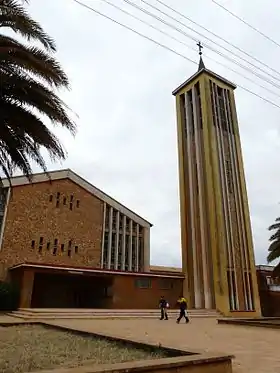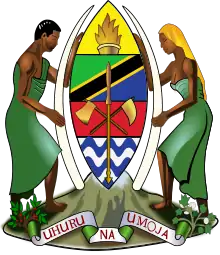Religion in Tanzania
Christianity is the largest religion in Tanzania according to the most recent estimates. There are also substantial Muslim and Animist minorities.
| Part of a series on the |
| Culture of Tanzania |
|---|
 |
| History |
| People |
| Languages |
| Religion |
| Sport |
|
Current statistics on the relative sizes of various religions in Tanzania are limited because religious questions have been eliminated from government census reports since 1967. A 2010 survey from the Pew Research Center found that 60% of the population are Christian, 36% are Muslim, 2% practice traditional religions and 1% are unaffiliated.[1]
Statistics


For many years estimates have been repeated that about a third of the population each follows Islam, Christianity and traditional religions.[2]
Religion-related statistics for Tanzania have been regarded as notoriously biased and unreliable.[3]
About 98 percent of the population in Zanzibar is Muslim.[4] There are also active communities of other religious groups, primarily on the mainland, such as Buddhists, Hindus, Sikhs, and Bahá'ís.[4]
Abrahamic
Christianity
The Christian population is largely composed of Roman Catholics, Orthodox and Protestants. Among the latter, the large number of Lutherans and Moravians point to the German past of the country while the number of Anglicans point to the British history of Tanganyika. All of them have had some influence in varying degrees from the Walokole movement (East African Revival), which has also been fertile ground for the spread of charismatic and Pentecostal groups.
Islam
On the mainland, Muslim communities are concentrated in coastal areas, with some large Muslim majorities also in inland urban areas especially and along the former caravan routes. The majority of the country's Muslim population is Sunni of Shafi school of jurisprudence; the remainder consists of several Shia subgroups (20%), mostly of Asian descent and the Ahmadiyya Islamic movement (15%),[5][6] and a smaller subset of Ibadism and nondenominational Muslim practitioners.[7]
Freedom of religion

The government of Tanzania and the semiautonomous government of Zanzibar both recognize religious freedom as a principle and make efforts to protect it. The government of Zanzibar appoints Muslim religious officials in Zanzibar. The main body of law in Tanzania and Zanzibar is secular, but Muslims have the option to use religious courts for family-related cases. Individual cases of religiously motivated violence have occurred against both Christians and Muslims, as well as those accused of witchcraft.[8] The freedom to practice religion is a human right in Tanzania.
Notable places of worship
- Azania Front Lutheran Church – Lutheran
- Christ Church, Zanzibar – Anglican
- Gaddafi Mosque – Islamic
- Great Mosque of Kilwa – Islamic (Historical)
- Ijumaa Mosque – Islamic
- Kizimkazi Mosque – Islamic
- St. Joseph's Cathedral, Dar es Salaam – Catholic
References
- "Tolerance and Tension: Islam and Christianity in Sub-Saharan Africa" (PDF). Pew Forum on Religious & Public life. April 2010. p. 20. Archived from the original (PDF) on 2016-03-12. Retrieved 25 April 2018.
- So repeated here: (USA government), Central Intelligence Agency. "The World Fact Book". Retrieved 25 May 2014.
- Abdulaziz Y. Lodhi and David Westerlund. "African Islam in Tanzania". Retrieved 25 May 2014.
- "International Religious Freedom Report for 2013" (PDF). United States Department of State. Retrieved 17 October 2014.
- "The World's Muslims: Unity and Diversity" (PDF). Pew Forum on Religious & Public life. August 9, 2012. Retrieved June 2, 2014.
- International Religious Freedom Report 2007: Tanzania. United States Bureau of Democracy, Human Rights and Labor (September 14, 2007). This article incorporates text from this source, which is in the public domain.
- Wortmann, Kimberly T. Omani Religious Networks in Contemporary Tanzania and Beyond. Diss. 2018.
- International Religious Freedom Report 2017 Tanzania, US Department of State, Bureau of Democracy, Human Rights, and Labor.
 This article incorporates text from this source, which is in the public domain.
This article incorporates text from this source, which is in the public domain.


